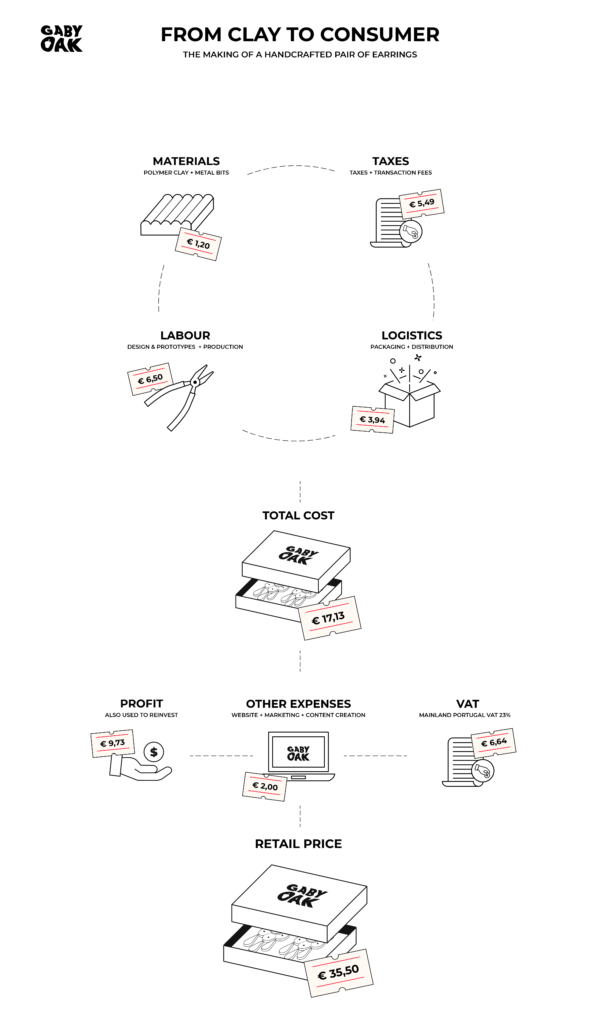TRANSPARENCY
TRANSPARENCY
When you choose to purchase at my store, you are investing in products that have been designed, constructed or assembled by my own hands. Keeping the production small and in-house makes sharing every part of the process possible.
As a customer, it is very important for me to make informed decisions and I appreciate brands that help me do this, without exploiting flawed or false definitions of ethicality and sustainability. I also like brands and artists that help me understand the true cost of their products in an era where low prices have become so normalized that we don’t even think what they usually mean.
For this reason, I want to share with you how everything is made, including the good and the not so good, no lies!
HOW IT IS MADE
My jewelry is made with polymer clay, which is a plastic (polyvinyl chloride) that reaches its final hardened state with baking. When properly baked, it becomes extremely durable and resistant to breakage.
I work with polymer clay in the most responsible way possible:



The brand of polymer clay I use to make your jewelry is Fimo, produced by a german company called Staedtler and the resin (when applied) is from Cléopâtre, a french company. I purchase them through portuguese retailers. I don’t have information about the origin of my metal components, but I buy them through portuguese retailers too. Buying locally supports other small businesses and cuts down carbon emissions from transportation.
Accessories like bucket hats are made from second hand clothes or surplus textiles. This means my pieces are mostly zero waste, rescuing materials from the landfill.
HOW IT IS PRICED
Raw materials, design, sampling, cutting, baking, sanding, buffing, assembling of metal components, packaging, duties, shipping, website fees: an incomplete list of what you pay for when you are purchasing a pair of earrings.
Many of the costs in this process are fixed. Producing in a small scale means not qualifying for minimum quantities to buy directly from factories at reduced prices; making everything by hand means more hours of elbow grease that need to be fairly compensated; having a legal business means a big amount of fees and taxes.
So how can all these materials, handwork, logistics and duties amount to just a couple of euros? It can’t. At least not without compromising quality, the living wage of the worker or the legitimacy of the business.
END OF LIFE
On a last note, if you don’t want your purchased items to be part of your life anymore please consider either gifting them to someone who will love them, donating them or or sending them back to me to incorporate in new designs instead of throwing them away. On the other hand, if you still love your items and they only need a repair, please have a look at the reparation tab in the website’s frequently asked questions page.
For more information please contact hello@gabyoak.com
When you choose to purchase at my store, you are investing in products that have been designed, constructed or assembled by my own hands. Keeping the production small and in-house makes sharing every part of the process possible.
As a costumer, it is very important for me to make informed decisions and I appreciate brands that help me do this, without exploiting flawed or false definitions of ethicality and sustainability. It also helps me understand the true cost of an item in an era where low prices have become so normalized that we don’t even second-guess what they mean – usually cheap labour.
For this reason, I want to share with you how everything is made, including the good and the not so good, no lies!
HOW IT IS MADE
My jewelry is made with polymer clay, which is a plastic (polyvinyl chloride) that reaches its final hardened state with baking. When properly baked, it becomes extremely durable and resistant to breakage.
I work with polymer clay in the most responsible way possible:



The brand of polymer clay I use to make your jewelry is Fimo, produced by a german company called Staedtler and the resin (when applied) is from Cléopâtre, a french company. I purchase them through portuguese retailers. I don’t have information about the origin of my metal components, but I buy them through portuguese retailers too. Buying locally supports other small businesses and cuts down carbon emissions from transportation.
Accessories like bucket hats are made from second hand clothes or surplus textiles. This means my pieces are mostly zero waste, rescuing materials from the landfill.
HOW IT IS PRICED
Raw materials, design, sampling, cutting, baking, sanding, buffing, assembling of metal components, packaging, duties, shipping, website fees: an incomplete list of what you pay for when you are purchasing a pair of earrings.
Many of the costs in this process are fixed. Producing in a small scale means not qualifying for minimum quantities to buy directly from factories at reduced prices; making everything by hand means more hours of elbow grease that need to be fairly compensated; having a legal business means a big chunk of taxes, both for the maker and the consumer.
So how can all these materials, handwork, logistics and duties amount to just a couple of euros? It can’t. At least not without compromising quality, the living wage of the worker or the legitimacy of the business.
END OF LIFE
On a last note, if you don’t want your purchased items to be part of your life anymore please consider either gifting them to someone who will love them, donating them or or sending them back to me to incorporate in new designs instead of throwing them away. On the other hand, if you still love your items and they only need a repair, please have a look at the reparation tab in the website’s frequently asked questions page.
For more information please contact hello@gabyoak.com
